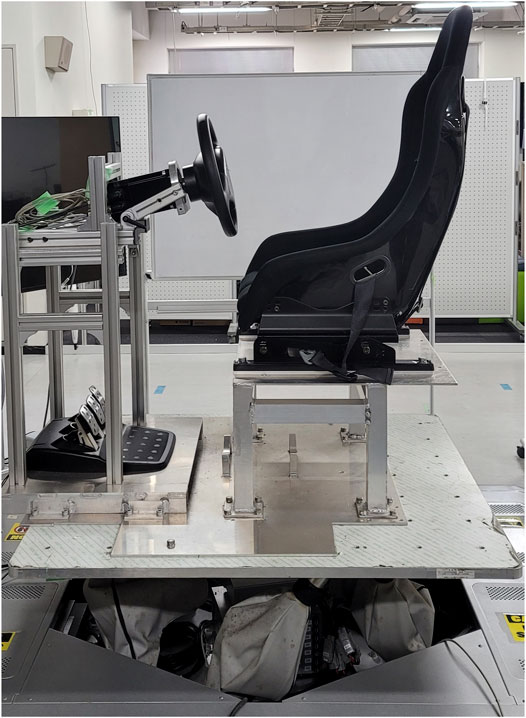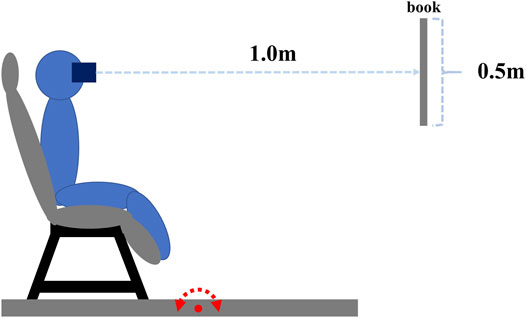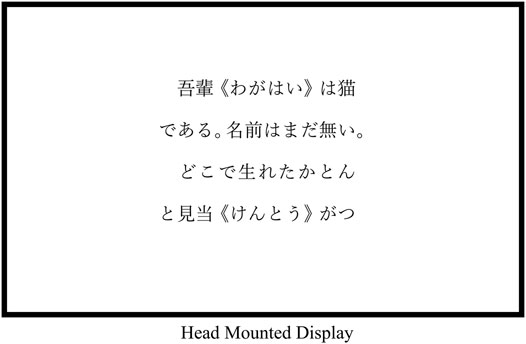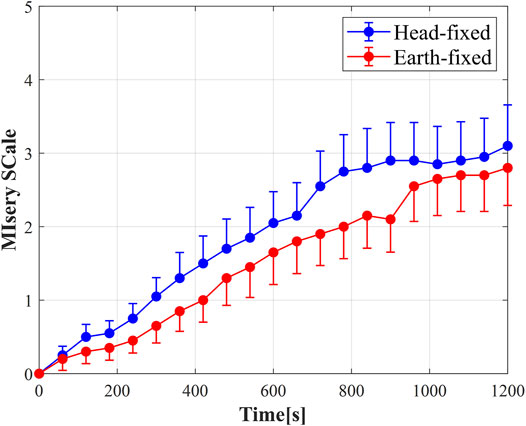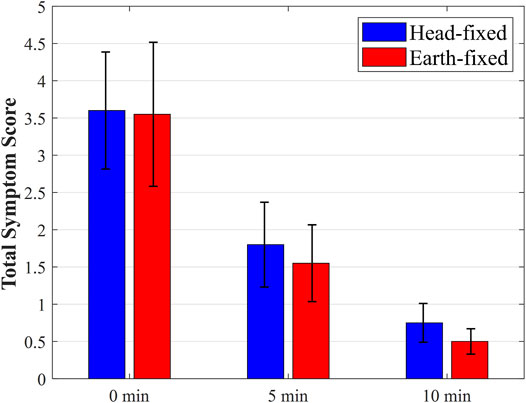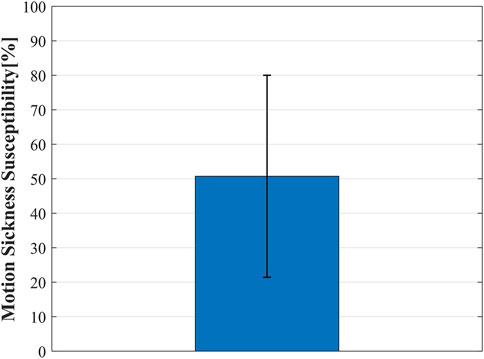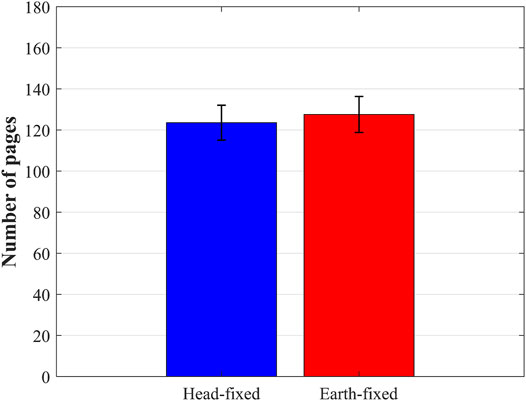- 1Nissan Research Center Nissan Motor Co., Ltd, Kanagawa, Japan
- 2Graduate School of Information Science and Engineering, Ritsumeikan University, Shiga, Japan
- 3Graduate School of Science and Technology, Nara Institute of Science and Technology, Ikoma, Japan
- 4Research Organization of Science and Technology, Ritsumeikan University, Kusatsu, Japan
There are concerns that viewing two-dimensional (2D) content such as web pages on a head-mounted display (HMD) in the car may aggravate motion sickness. This is because when 2D content is fixed to a head-fixed coordinate system, the appearance of the content does not change even when the body moves; therefore, it is impossible to visually perceive the movement of one’s body, resulting in a sensory conflict between the visual and vestibular senses. A method for reducing motion sickness when displaying 3D content on an HMD has been investigated; however, when displaying 2D content, no such method has been investigated. Therefore, this study aims to verify to the possibility of reducing motion sickness from the change of appearance caused by fixing 2D content to the earth-fixed coordinate system when viewing it with an HMD in a moving environment. Participants sat on a seat that was mounted on a vibrating device and moved in the pitch direction while reading a book on the HMD. Consequently, the severity of motion sickness was significantly lower when the book was fixed to the earth-fixed coordinate system than when fixed to the head-fixed coordinate system. This result suggests that by fixing the content to the earth-fixed coordinate system, motion sickness can be reduced because the movement of one’s body can be perceived through changes in the appearance of the content, and the sensory conflict between visual and vestibular sensations can be resolved.
1 Introduction
Motion sickness is a common syndrome associated with nausea/vomiting, and it primarily occurs because of exposure to certain types of real or perceived motions. Depending on the mode of transport or environment, motion sickness is classified as “car sickness,” “seasickness,” or “space sickness.” Visually induced motion sickness (VIMS) (Keshavarz et al., 2015) is a motion sickness caused by visual stimuli such as video games and driving simulators (Merhi et al., 2007; Brooks et al., 2010). In particular, VIMS caused by virtual environments using HMDs is classified as “cyber sickness” (McCauley and Sharkey, 1992), VIMS caused by video games as “game sickness” (Merhi et al., 2007; Keshavarz et al., 2015), and VIMS caused by driving simulators and flight simulators as “simulator sickness” (Brooks et al., 2010). The mechanism of motion sickness has been the subject of many hypotheses. The sensory conflict theory (Reason J., 1978; Reason JT., 1978; Rolland et al., 1995) postulates that motion sickness occurs when there is a mismatch between current input patterns from sensory modalities (vision and vestibular) and past input pattern experiences retained in the central nervous system. This means that an abnormal combination or discrepancy among neural signals from different sensory modalities, such as visual and vestibular signals, is one of the causes of this conflict. According to the subjective vertical conflict theory, which is a derivative of the sensory conflict theory, motion sickness is caused by a conflict between the subjective vertical direction estimated using input patterns from the eyes, vestibular system, and non-vestibular proprioceptors, and the subjective vertical direction estimated based on experience (Bles et al., 1998). Other possible causes of motion sickness are the stimulation of the vagus nerve by eye movement in the eye movement theory (Ebenholtz et al., 1994), posture instability in the postural instability theory (Riccio and Stoffregen, 1991), and the reaction of the toxin warning mechanism owing to the confusion of the spatial reference between the sensory organs in the evolutionary hypothesis (Treisman, 1977). In particular, according to the sensory conflict theory, the cause of motion sickness when reading a book in a car is a conflict between vision and vestibular sensation, in which the vestibular sensation responds without the sensory signal from vision (Reason J., 1978; Reason JT., 1978).
Recently, automated driving has made it possible to perform non-driving tasks in a car, such as reading or operating a tablet; however, this may increase the risk of motion sickness (Wada, 2016). In fact, viewing content on the in-vehicle display while driving causes motion sickness that is about twice as severe as when the task is not performed (Morimoto et al., 2008). According to Kato and Kitazaki (2008), this is caused by the conflict between vision and vestibular sensation, in which the vestibular senses respond without expected sensory signals from vision because viewing content prevents the perception of vehicle and body motion from vision. Therefore, they proposed a method for displaying content on the in-vehicle display that makes it appear to be fixed to the earth-fixed coordinate system. They reported that changing the visual appearance of the content enabled visual perception of body movements in the earth-fixed coordinate system, which minimized the conflict between the visual and vestibular senses and reduced motion sickness.
Head-mounted display (HMD) is expected to be a new way to provide content in a moving vehicle (Li et al., 2021; McGill et al., 2017; Hock et al., 2017) because it has an advantage in that it allows the user to watch videos and read books on a large virtual screen even in a small space. However, as with in-vehicle displays, there is concern that the use of HMDs may lead to motion sickness owing to a conflict between visual and vestibular sensations because the vehicle and body motions cannot be perceived when viewing the content (Li et al., 2021). Furthermore, viewing content on an HMD causes more severe motion sickness than viewing content on an indoor display (Dennison et al., 2016; Yildirim, 2020); there is also a concern that using an HMD in a moving vehicle will cause more severe motion sickness than when using an in-car display. While using an HMD in a moving vehicle, it was demonstrated that reducing the conflict between visual and vestibular sensations by allowing users to perceive vehicle and body movements through a 3D virtual environment corresponding to the real environment reduces motion sickness (Hock et al., 2017). Many studies have been conducted on measures to reduce cyber sickness (Shi et al., 2021), including the introduction of an earth-fixed frame (Shahnewaz Ferdous et al., 2021; Shi et al., 2021) and prediction methods for sickness reduction (Chang et al., 2021; Islam et al., 2021; Monteiro et al., 2021); however, in all these studies, HMD application in moving vehicles was not considered. Further research is required to determine whether these methods are effective for moving vehicles.
In addition to 3D content such as buildings and trees, viewing 2D content such as web pages and e-books displayed on a 2D plane can be considered a possible use of an HMD in a car. However, to the best of our knowledge, previous studies have not clarified whether it is possible to reduce motion sickness when viewing 2D content on HMDs in an externally moving environment, such as a car. Therefore, the purpose of our study is to verify whether fixing 2D content to the earth-fixed coordinate system can reduce motion sickness when viewing its projection on an HMD in an externally moving environment, such as a car. Based on the sensory conflict theory, we hypothesized that motion sickness can be reduced by fixing 2D content to the earth-fixed coordinate system when viewing it on an HMD in an externally moving environment because body movement can be perceived from vision and the conflict between vision and vestibular sensation can be reduced. We used a vibration device to give the participants body movement stimuli in the pitch direction while they read aloud text written on a 2D virtual plane in a virtual 3D space projected on the HMD, which we refer to as “book” in this study. We compared the severity of motion sickness in the earth-fixed and head-fixed conditions, in which the book was fixed to the earth-fixed coordinate system and the head-fixed coordinate system, respectively.
The structure of this paper is as follows. In Section 2, we describe the method of an experiment to verify the possibility of reducing motion sickness by fixing the book on the HMD to the earth-fixed coordinate system in an externally moving environment. In Section 3, the experimental results are described, and in Section 4, the results are discussed.
2 Materials and Methods
2.1 Participants
Twenty adults [three females with an average age of 22.5 (M) ± 1.4 (SD) years, range 20–24] participated in the study. The following criteria were used to select the participants: 1) they should have sufficient vision to read a book in the Virtual Reality (VR) space with their naked eyes, contacts, or glasses, and 2) they must be able to calibrate their gaze with the HMD. All participants were unaware of the purpose of this study and were unfamiliar with the experimental task and rationale. All participants provided informed written consent prior to participating in the study. The Ritsumeikan University Ethics Review Committee for Medical and Health Research Involving Human Subjects approved all employed procedures.
2.2 Vibration Device
Participants wearing an HMD sat on a device that vibrated in the pitch direction (Figure 1). The pitch angle of the vibration device was controlled by transmitting waveform signals of the angle change at 20 ms intervals using MATLAB 2019b. The waveform signals consisted of a random combination of two waveforms and a stop interval, as shown Figure 2. The two waveforms differed only in phase: a sine wave with a phase ranging from 0 to π rad and a sine wave with a phase ranging from 0 to -π rad. Both waveforms had a frequency of 0.2 Hz and an amplitude of 0.15 rad. The pause interval between the two waveforms was randomly set between 1 and 3 s. The maximum vibration time was 20 min.
2.3 Head-Mounted Display Reading Task Under Vibration
The participants performed an HMD reading task while sitting on the device that vibrated in the pitch direction and reading aloud a book displayed in the VR environment of the HMD for up to 20 min, as shown in Figures 3, 4. The book was displayed 1.0 m in front of the participants and the background of the book was entirely white. The book was 0.5 m long and wide, with 44 characters (4 in length and 11 in width) printed within 0.3 m. The letters were 24 pt in size, which was large enough for the participants to see. The participants read aloud the book in front of them while vibrating, and when they finished reading a page, they pulled the trigger of the controller to turn the page and continued reading aloud. The VR environment was created using Unity 2018.3.7. HTC Vive Pro Eye with a resolution of 2880 × 1600 pixels (1440 × 1600 pixels per eye), a maximum field of view of 110°, and rendered at 90 Hz, was used as the HMD.
2.4 Experimental Factor
The experimental factor was the reference coordinate system to which the book was fixed, and there were two conditions: head-fixed and earth-fixed. In the head-fixed condition, the book was fixed to the head-fixed coordinate system, and in the earth-fixed condition, the book was fixed to the earth-fixed coordinate system. In the head-fixed condition, the appearance of the book on the HMD does not change even when the body moves, and thus the body movement cannot be perceived. In the earth-fixed condition, the appearance of the book on the HMD changes when the body moves, and thus the body motion can be perceived.
2.5 Measure of Motion Sickness
We used the motion sickness susceptibility questionnaire (MSSQ) (Golding, 2006), MIsery SCale (MISC) (Bos et al., 2005), total symptom score (TSS) (Golding et al., 1995), and the relative evaluation questionnaire (REQ) as measures of motion sickness severity.
2.5.1 Motion Sickness Susceptibility Questionnaire
The MSSQ is a questionnaire that evaluates susceptibility to motion sickness based on the results of a five-point scale (never, never, seldom, sometimes, and often) in which participants rate how often they have experienced motion sickness in various types of vehicles (passenger cars, buses, trains, airplanes, small boats, ships, swings, spinning rides, and amusement park rides) in their childhood up to age 12 and in the past decade from the present.
2.5.2 MIsery SCale
MISC is an 11-point rating evaluation index for determining the severity of motion sickness (Table 1). Participants verbally reported the severity of motion sickness every minute during the HMD reading task under vibration for up to 20 min.
2.5.3 Total Symptom Score
The TSS is an evaluation index that assesses the severity of motion sickness by the total value in each rating of motion sickness symptoms (dizziness, warm, headache, sweating, stomach awareness, salivation, nausea, pallor, and others) on a four-point scale (not at all: 0, slight: 1, rather: 2, and severe: 3). TSS was evaluated immediately after the reading task, 5 min later and 10 min later.
2.5.4 Relative Evaluation Questionnaire
The REQ is a five-point rating evaluation index that assesses the relative severity of motion sickness disease in both the head-fixed and earth-fixed conditions (Table 2). The participants were asked to choose which condition caused them more severe motion sickness after the two conditions were completed.
2.6 Procedure
We explained the experiment to the participants and asked for their informed consent. After the informed consent was obtained, the MSSQ was evaluated. The participants were then seated on the vibration device while wearing the HMD and holding the controller. Then, they calibrated their gaze. Following calibration, the participants began the HMD reading task under vibration in either the head-fixed or the earth-fixed conditions. During the task, the participants were required to answer the MISC every minute. They completed the TSS immediately after the reading task, 5 min later and 10 min later. The following day, the same procedure was repeated under different conditions, and the participants answered the REQ. To eliminate order effects, on the first day, half of the participants performed the head-fixed condition, while the other half performed the earth-fixed condition.
The HMD reading task lasted for up to 20 min, but if the participant answered six (weakly felt nausea or vexation) in the MISC, the reading task was extended for another 2 min before being terminated. When the participants answered seven (moderate nausea or vexation) on the MISC, the reading task was terminated immediately. To record the MISC when the reading task was interrupted, the blank space between the time of interruption and the end of the HMD reading task was supplemented with the MISC score at the time of interruption. The numbers of completed pages of the book in each condition at the time of the interruption were compared in the reading task performance.
2.7 Statistical Analysis
Because the Kolmogorov-Smirnov test indicated that the assumptions of data normality were violated for REQ, MISC, TSS, and reading task performance, we used non-parametric Wilcoxon signed-rank test for comparing the head-fixed and earth-fixed conditions.
3 Results
In this experiment, six out of 20 participants interrupted the HMD reading task. Two out of six participants interrupted the task in both conditions, three participants interrupted the task in the head-fixed condition, and one participant interrupted the task in the earth-fixed condition.
3.1 Relative Evaluation Questionnaire
Figure 5 shows the mean and standard error of the REQ for all participants. The median REQ was significantly greater than zero, indicating that motion sickness was more severe in the head-fixed condition than in the earth-fixed condition (
3.2 MIsery SCale
Figure 6 shows the mean and standard error of MISC for all participants. The Wilcoxon signed rank test indicated that the reference coordinate system factor had no significant effect on the average value of MISC over the entire time (
3.3 Total Symptom Score
Figure 7 depicts the mean and standard error of the TSS for all participants. The Wilcoxon signed rank test revealed that the reference coordinate system factor had no significant effect on the average value of TSS over the entire time (z = 0.806, p = 0.506, two-tailed). Moreover, the Wilcoxon signed rank test indicated that the experimental order had no significant effect on the TSS (
3.4 Motion Sickness Susceptibility Questionnaire
Figure 8 shows the mean and standard deviation of the MSSQ for all participants (
3.5 Reading Task Performance
Figure 9 shows the mean and standard error of the reading task performance of all participants. There was no significant difference in the median for each condition (
4 Discussion and Conclusion
The purpose of this study was to verify the possibility of reducing motion sickness by fixing the 2D content to the earth-fixed coordinate system when viewing 2D content on the HMD in an externally moving environment. Participants sat on a device that vibrated in the pitch direction while reading aloud from a book projected on the HMD. As a result, the relative severity of motion sickness was significantly lower in the earth-fixed condition, where the book was fixed to the earth-fixed coordinate system, than in the head-fixed condition, where the book was fixed to the head-fixed coordinate system. In the head-fixed condition, the appearance of the book did not change even when the participant moved; therefore, the participant could not perceive body motion from vision. However, in the earth-fixed condition, the appearance of the book on the HMD changes as the body moves, allowing body motion to be perceived. Based on the sensory conflict theory, the reduction of the motion sickness in the earth-fixed condition can be interpreted as a decrease in the conflict between vision and vestibular senses. From the viewpoint of the postural instability theory, the experimental result can also be interpreted to mean that the earth-fixed condition improved postural stability. This study is the first to demonstrate that motion sickness can be reduced by fixing the 2D content to the earth-fixed coordinate system when viewing 2D content on the HMD in an externally moving environment, such as a car.
The findings of this study are consistent with those of studies on motion sickness reduction by Kato and Kitazaki (2008) and Hemmerich et al. (2020). Kato and Kitazaki (2008) proposed a method for reducing the conflict between vision and vestibular sensation, and motion sickness by displaying 2D content such that it can appear to be fixed to the earth-fixed coordinate system using an in-vehicle display, and by making people perceive body motion from the change in the appearance of the 2D content. The novelty of our study compared with the study by Kato and Kitazaki (2008) is that we used an HMD rather than an in-vehicle display. When using an in-vehicle display, the 2D content is fixed to the vehicle-fixed coordinate system, allowing the body motion in the earth-fixed coordinate system to be perceived visually by complementing the vehicle motion. However, when using an HMD, the 2D content is fixed in the head-fixed coordinate system, allowing the body motion to be perceived visually by complementing the body motion in the earth-fixed coordinate system. Although the motions complemented in in-vehicle displays and HMDs are different, our study is the first to demonstrate that motion sickness can be reduced not only in in-vehicle displays but also in HMDs by fixing the content to the earth-fixed coordinate system.
Hemmerich et al. (2020) used an HMD in their motion sickness reduction study, but unlike ours, it was not in an environment where the body was moved. In their experiment, a participant wore an HMD and sat still while being shown 3D content that included a starfield diffused conically from the front. The starfield gave the participant the illusion that the body was moving, causing motion sickness. They reported that presenting a horizon line fixed to the earth-fixed coordinate system significantly reduced the visually induced motion sickness because the horizon made the participant perceive the body motion in the earth-fixed coordinate system as stationary, thereby reducing the conflict between the visual and vestibular senses. A difference between their study and ours is the state of external movement of the body, i.e., whether it is moving or stationary. Another difference is that viewing the content displayed on the HMD causes the body to perceive movement or stillness. Therefore, in their study, there was a sensory conflict, in which the body was visually moving while viewing diffused starfield but was stationary in the vestibular sense. In this study, there was a different type of sensory conflict, in which the body was visually stationary while viewing a book fixed to the head-fixed coordinate system but moved in the vestibular sense. In their study, the sensory conflict was reduced by presenting a horizon line fixed to the earth-fixed coordinate system because the horizon line makes the body perceive itself as stationary. In our study, the sensory conflict was reduced by presenting a book fixed to the earth-fixed coordinate system because the book causes the body to perceive movement. Although the method for presenting content fixed to the earth-fixed coordinate system on the HMD is common, this study is the first to demonstrate that motion sickness can be reduced when viewing 2D content on HMDs in an externally moving environment.
Our method has a limitation in terms of reducing motion sickness. In this study, motion sickness was evaluated using three indices, and only REQ showed a significant reduction in motion sickness, while MISC and TSS showed no significant reduction. Therefore, it is necessary to improve the method to further reduce motion sickness. In our method, the body motion is perceived from the appearance of 2D content in the central visual field, but body motion cannot be perceived from the peripheral visual field because of the white background of the 2D content. Morimoto et al. (2008) showed that the discomfort was significantly reduced by projecting vehicle motion information on the background of the video while watching it on the in-car display. This is thought to be because body motion can be perceived through peripheral vision, thereby reducing the conflict between the visual and vestibular senses. Therefore, our method may further reduce motion sickness by adding visual information of body movements to the background of the 2D content. Another limitation is that there is only one type of vibration frequency and amplitude in the body movement stimuli. It is necessary to verify whether our method is effective in more general vibration environments, such as those with different motion directions, frequencies, and amplitudes. Another limitation of this study is that we have not examined the effect of the delay in displaying the book on motion sickness. Even in the earth-fixed condition, if there is a display delay, motion sickness may occur owing to new sensory conflict between vestibular sensuously perceived head movements and visually perceived head movements owing to the displayed book with the delay (Palmisano et al., 2020; Chang et al., 2020). Furthermore, the perceived scene instability was not considered in this study. Even in the head-fixed condition, the scene perception may be unstable owing to the pitch movement and motion sickness may occur (Kim et al., 2020). Future studies must examine the effects of the delay in displaying the book and perceived scene instability on motion sickness.
Future research could also focus on applying the motion sickness reduction method used in this study to vehicles. In our method, the 2D content was fixed to the earth-fixed coordinate system to perceive body motion from changes in the appearance of the 2D content. However, when translational motion is involved, such as in the case of a moving car, the 2D content that is fixed to the earth-fixed coordinate system will be left behind by the movement and will be out of view. Therefore, it is necessary to modify our method to make it vehicle-friendly. For example, instead of reflecting all degrees of freedom of body motion in the 2D content, a method that ignores the translational motion component and reflects only the rotational motion component in the appearance of the 2D content can be considered. With this method, the 2D content is not left behind and the rotational component of body motion can be perceived, which may lead to the development of a vehicle-based method for reducing motion sickness. Another possible method is to present body movement information in the background of the 2D contents fixed to the head-fixed coordinate system instead of the earth-fixed coordinate system. For example, a method for presenting a striped pattern or a virtual environment that reflects body movement, or a method for presenting an image of a camera that is fixed to the windshield of a vehicle can be considered. If the effect of reducing motion sickness can be confirmed using these methods, it may be possible to reduce motion sickness when viewing 2D content on an HMD in a real vehicle, which could help improve vehicle productivity.
Data Availability Statement
The raw data supporting the conclusions of this article will be made available by the authors, without undue reservation.
Ethics Statement
The studies involving human participants were reviewed and approved by The Ritsumeikan University Ethics Review Committee for Medical and Health Research Involving Human Subjects. The patients/participants provided their written informed consent to participate in this study.
Author Contributions
HS contributed to the data collection, data analysis, and wrote the first draft of the manuscript; HS, YS, and TW conceived the study, designed the experiment. All authors contributed to interpretation of the results, the manuscript revision and approved the submitted version.
Funding
This study received funding from Nissan Motor Co., Ltd and Japan Science and Technology Agency Grant (# JPMJTR20RR). The funders were not involved in the study design, collection, analysis, interpretation of data, the writing of this article or the decision to submit it for publication. All authors declare no other competing interests.
Conflict of Interest
HS, AT, and MM are employed by Nissan Motor Co., Ltd. The remaining authors declare that the research was conducted in the absence of any commercial or financial relationships that could be construed as a potential conflict of interest.
Publisher’s Note
All claims expressed in this article are solely those of the authors and do not necessarily represent those of their affiliated organizations, or those of the publisher, the editors and the reviewers. Any product that may be evaluated in this article, or claim that may be made by its manufacturer, is not guaranteed or endorsed by the publisher.
References
Bles, W., Bos, J. E., de Graaf, B., Groen, E., and Wertheim, A. H. (1998). Motion Sickness: Only One Provocative Conflict? Brain Res. Bull. 47 (5), 481–487. doi:10.1016/S0361-9230(98)00115-4
Bos, J. E., MacKinnon, S. N., and Patterson, A. (2005). Motion Sickness Symptoms in a Ship Motion Simulator: Effects of inside, outside, and No View. Aviat. Space Environ. Med. 76 (12), 1111–1118.
Brooks, J. O., Goodenough, R. R., Crisler, M. C., Klein, N. D., Alley, R. L., Koon, B. L., et al. (2010). Simulator Sickness during Driving Simulation Studies. Accid. Analysis Prev. 42 (3), 788–796. doi:10.1016/j.aap.2009.04.013
Chang, E., Kim, H. T., and Yoo, B. (2021). Predicting Cybersickness Based on User's Gaze Behaviors in HMD-Based Virtual Reality. J. Comput. Des. Eng. 8 (2), 728–739. doi:10.1093/jcde/qwab010
Chang, E., Kim, H. T., and Yoo, B. (2020). Virtual Reality Sickness: A Review of Causes and Measurements. Int. J. Human-Computer Interact. 36 (17), 1658–1682. doi:10.1080/10447318.2020.1778351
Dennison, M. S., Wisti, A. Z., and D’Zmura, M. (2016). Use of Physiological Signals to Predict Cybersickness. Displays 44 (September), 42–52. doi:10.1016/j.displa.2016.07.002
Ebenholtz, S. M., Cohen, M. M., and Linder, B. J. (1994). The Possible Role of Nystagmus in Motion Sickness: A Hypothesis. Aviat. Space Environ. Med. 65 (11), 1032–1035.
Golding, J. F., Markey, H. M., and Stott, J. R. R. (1995). The Effects of Motion Direction, Body Axis, and Posture on Motion Sickness Induced by Low Frequency Linear Oscillation. Aviat. Space Environ. Med. 66 (11), 1046–1051.
Golding, J. F. (2006). Predicting Individual Differences in Motion Sickness Susceptibility by Questionnaire. Personality Individ. Differ. 41 (2), 237–248. doi:10.1016/j.paid.2006.01.012
Hemmerich, W., Keshavarz, B., and Hecht, H. (2020). Visually Induced Motion Sickness on the Horizon. Front. Virtual Real. 1 (November), 1–10. doi:10.3389/frvir.2020.582095
Hock, P., Benedikter, S., Gugenheimer, J., and Rukzio, E. (2017). “CarVR,” in Conference on Human Factors in Computing Systems - Proceedings, New York, NY, USA, 2017-May (ACM), 4034–4044. doi:10.1145/3025453.3025665
Islam, R., Desai, K., and Quarles, J. (2021). “Cybersickness Prediction from Integrated HMD's Sensors: A Multimodal Deep Fusion Approach Using Eye-Tracking and Head-Tracking Data,” in 2021 IEEE International Symposium on Mixed and Augmented Reality (ISMAR), Bari, Italy, 4-8 Oct. 2021, 31–40. doi:10.1109/ISMAR52148.2021.00017
Kato, K., and Kitazaki, S. (2008). Improvement of Ease of Viewing Images on an In-Vehicle Display and Reduction of Carsickness. SAE Tech. Pap. 2008 (724), 565. doi:10.4271/2008-01-0565
Keshavarz, B., Riecke, B. E., Hettinger, L. J., and Campos, J. L. (2015). Vection and Visually Induced Motion Sickness: How Are They Related? Front. Psychol. 6 (APR), 1–11. doi:10.3389/fpsyg.2015.00472
Kim, J., Luu, W., and Palmisano, S. (2020). Multisensory Integration and the Experience of Scene Instability, Presence and Cybersickness in Virtual Environments. Comput. Hum. Behav. 113, 106484. doi:10.1016/j.chb.2020.106484
Li, J., Reda, A., and Butz, A. (2021). “Queasy Rider: How Head Movements Influence Motion Sickness in Passenger Use of Head-Mounted Displays,” in 13th International Conference on Automotive User Interfaces and Interactive Vehicular Applications, New York, NY, United States, September 2021, 28–38. doi:10.1145/3409118.3475137
McCauley, M. E., and Sharkey, T. J. (1992). Cybersickness: Perception of Self-Motion in Virtual Environments. Presence Teleoperators Virtual Environ. 1 (3), 311–318. doi:10.1162/pres.1992.1.3.311
McGill, M., Ng, A., and Brewster, S. (2017). “I Am the Passenger,” in Conference on Human Factors in Computing Systems - Proceedings, New York, NY, United States, 2017-May (Association for Computing Machinery), 5655–5668. doi:10.1145/3025453.3026046
Merhi, O., Faugloire, E., Flanagan, M., and Stoffregen, T. A. (2007). Motion Sickness, Console Video Games, and Head-Mounted Displays. Hum. Factors 49 (5), 920–934. doi:10.1518/001872007X230262
Monteiro, D., Liang, H.-N., Tang, X., and Irani, P. (2021). “Using Trajectory Compression Rate to Predict Changes in Cybersickness in Virtual Reality Games,” in 2021 IEEE International Symposium on Mixed and Augmented Reality (ISMAR), Bari, Italy, 4-8 Oct. 2021, 138–146. doi:10.1109/ISMAR52148.2021.00028
Morimoto, A., Isu, N., Ioku, D., and Asano, H. (2008). “Effects of Reading Books and Watching Movies on Inducement of Car Sickness,” in Proceedings of the FISITA 2008 World Automotive Congress, 14–19.
Palmisano, S., Allison, R. S., and Kim, J. (2020). Cybersickness in Head-Mounted Displays Is Caused by Differences in the User's Virtual and Physical Head Pose. Front. Virtual Real. 1, 24. doi:10.3389/frvir.2020.587698
Reason, J. (1978a). Motion Sickness: Some Theoretical and Practical Considerations. Appl. Ergon. 9, 163–167. doi:10.1016/0003-6870(78)90008-x
Reason, J. T. (1978b). Motion Sickness Adaptation: A Neural Mismatch Model. J. R. Soc. Med. 71 (November), 819–829. doi:10.1177/014107687807101109
Riccio, G. E., and Stoffregen, T. A. (1991). An Ecological Theory of Motion Sickness and Postural Instability. Ecol. Psychol. 3, 195–240. doi:10.1207/s15326969eco0303_2
Rolland, J. P., Biocca, F. A., Barlow, T., and Kancherla, A. (1995). “Quantification of Adaptation to Virtual-Eye Location in See-Thru Head-Mounted Displays,” in Proceedings - Virtual Reality Annual International Symposium, Research Triangle Park, NC, USA, 11-15 March 1995, 56–66. doi:10.1109/vrais.1995.512480
Shahnewaz Ferdous, S. M., Chowdhury, T. I., Arafat, I. M., and Quarles, J. (2021). Static Rest Frame to Improve Postural Stability in Virtual and Augmented Reality. Front. Virtual Real. 1, 45. doi:10.3389/frvir.2020.582169
Shi, R., Liang, H.-N., Wu, Y., Yu, D., and Xu, W. (2021). Virtual Reality Sickness Mitigation Methods. Proc. ACM Comput. Graph. Interact. Tech. 4 (1), 1–16. doi:10.1145/3451255
Treisman, M. (1977). Motion Sickness: An Evolutionary Hypothesis. Science 197 (4302), 493–495. doi:10.1126/science.301659
Wada, T. (2016). Motion Sickness in Automated Vehicles. Adv. Veh. Control AVEC 16, 169–174. doi:10.1201/9781315265285-28
Keywords: Motion Sickiness, sensory conflict theory, reading task, head mounted display, virtual reality, 2D content, Earth-fixed coordinate system, Cyber Sickness
Citation: Sato H, Sato Y, Takamatsu A, Makita M and Wada T (2022) Earth-Fixed Books Reduce Motion Sickness When Reading With a Head-Mounted Display. Front. Virtual Real. 3:909005. doi: 10.3389/frvir.2022.909005
Received: 31 March 2022; Accepted: 05 May 2022;
Published: 24 May 2022.
Edited by:
Hai-Ning Liang, Xi’an Jiaotong-Liverpool University, ChinaReviewed by:
Stephen Palmisano, University of Wollongong, AustraliaRuixuan Li, Idaho National Laboratory (DOE), United States
Copyright © 2022 Sato, Sato, Takamatsu, Makita and Wada. This is an open-access article distributed under the terms of the Creative Commons Attribution License (CC BY). The use, distribution or reproduction in other forums is permitted, provided the original author(s) and the copyright owner(s) are credited and that the original publication in this journal is cited, in accordance with accepted academic practice. No use, distribution or reproduction is permitted which does not comply with these terms.
*Correspondence: Hikaru Sato, aGlrYXJ1LXNhdG9AbWFpbC5uaXNzYW4uY28uanA=; Yuki Sato, c2F0by55dWtpQGlzLm5haXN0Lmpw
 Hikaru Sato
Hikaru Sato Yuki Sato
Yuki Sato Atsushi Takamatsu
Atsushi Takamatsu Mitsuhiro Makita
Mitsuhiro Makita Takahiro Wada
Takahiro Wada